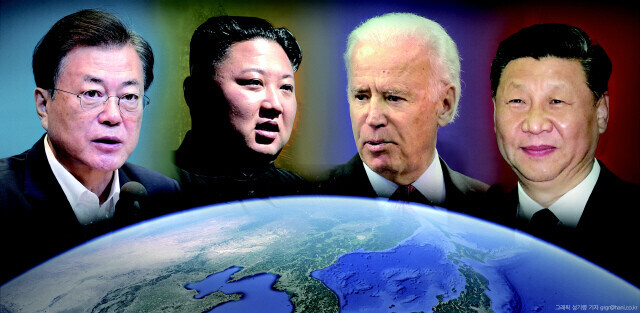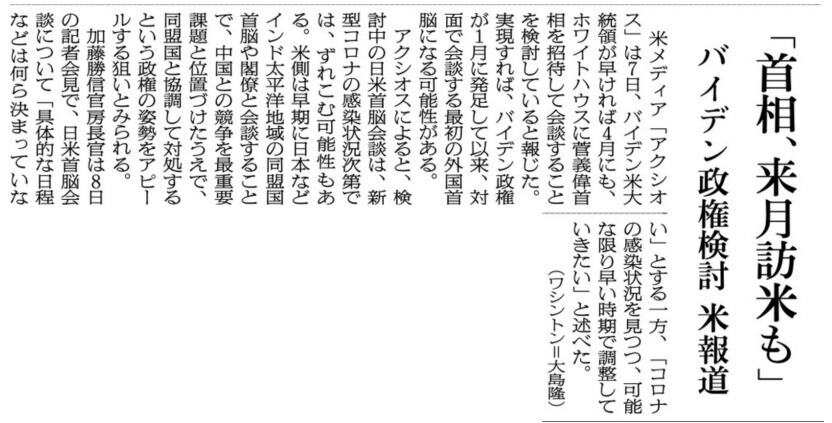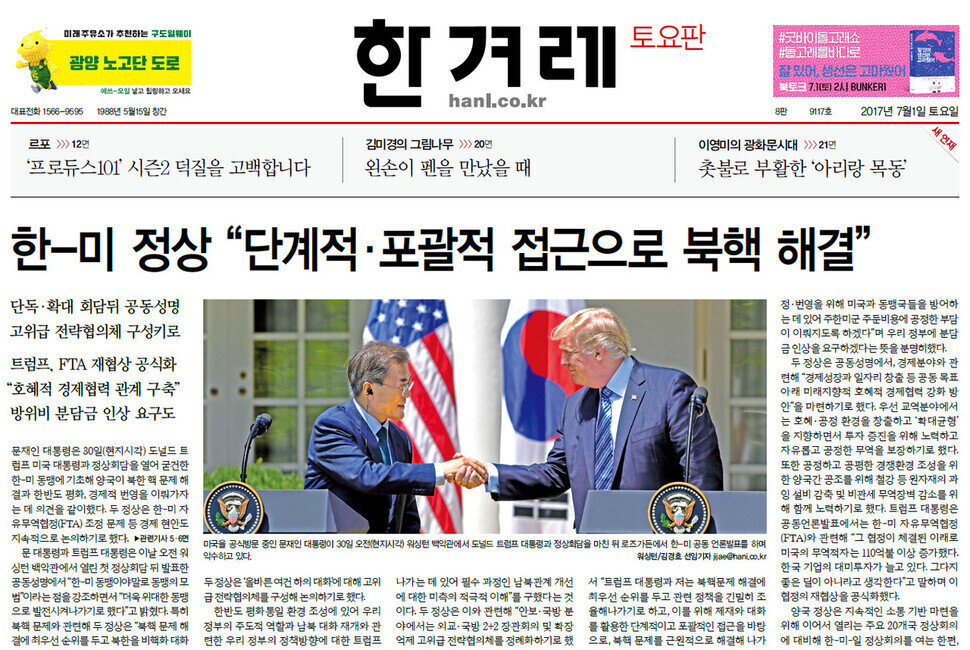hankyoreh
Links to other country sites 다른 나라 사이트 링크
[News analysis] When will Moon meet Biden and where?

The pace of the US administration’s diplomatic activities has been picking up since President Joe Biden’s inauguration on Jan. 20.
In contrast with predecessor Donald Trump’s “America first” focus, the new administration has shown clear signs of seeking to respond to various diplomatic issues by strengthening its relationships with allies that share key values such as democracy and human rights.
On March 3, US Secretary of State Antony Blinken laid out the direction of the Biden administration’s future diplomatic policies in a speech titled “A Foreign Policy for the American People.” The same day, the White House released a document titled “Interim National Security Strategic Guidance,” which stated the basic vision for the new administration’s foreign affairs and national security strategy.
In the document, China is described as “the only competitor potentially capable of combining its economic, diplomatic, military, and technological power to mount a sustained challenge to a stable and open international system.”
The direction indicated by the speech and documents is clear: joining forces with allies to confront China, the only rival with the capabilities to challenge the US.
An alliance is a relationship in which two parties have resolved to fight side-by-side when difficulties arise. So if the US is asking its allies to join forces against its rival China, words alone are not enough.
It needs to meet face-to-face, shake hands, and cement that commitment anew through agreements reached after heated discussion. Even if the world is suffering under the strain of the COVID-19 pandemic, even if video meetings have now become standard practice, it still matters at a human level for us to meet in person.
So when is an in-person summit likely to occur between the leaders of South Korea and the US?To answer that question, we must consider many things. In diplomacy, things like formalities and proper orders matter. When an important diplomatic issue arises, it is first discussed at the working level; once an agreement is reached, it progresses to the next level of talks.
If the two sides can reach a consensus at the end of this process, they will hold the next level of talks at the foreign minister or sometimes the summit level, depending on the matter’s importance.
For South Korean President Moon Jae-in, this summit with the US is very important indeed. With the end of his term approaching in May 2022, this is effectively the last chance he has to get the ball rolling again on the “Korean Peninsula peace process” that he has put so much effort into.
But in terms of its North Korea policy, the new US administration had only announced plans in basic terms to reexamine its approach while consulting with allies such as South Korea and Japan. Seoul and Washington need to maintain close communication to ensure an outcome beneficial to South Korea.
In the past, South Korea and the US have indeed maintained close communication at different levels. While the media do not report individually on every development, the South Korean Ministry of Foreign Affairs (MOFA) does issue short press releases every time there is a telephone conversation or video meeting with its US counterparts.
From these, we can see some of the communication that has been taking place: between Minister of Foreign Affairs Chung Eui-yong and Blinken on Feb. 12, between Special Representative for Korean Peninsula Peace and Security Affairs Noh Kyu-duk and Acting Assistant Secretary of State for East Asian and Pacific Affairs Sung Kim on Feb. 10, and between MOFA Deputy Director-General for North American Affairs Ko Yun-ju and Deputy Assistant Secretary of State for East Asian and Pacific Affairs Marc Knapper on Feb. 8 and March 2.
Additionally, there has been communication between Blue House National Security Office Director Suh Hoon and White House National Security Advisor Jake Sullivan. We can also surmise that there has been a lot of other communication that officials have not released details about.

So when might the South Korean and US leaders meet in person? Before a summit takes place, it’s customary for foreign ministers to meet.
In that sense, the reporting from some Japanese media on March 4 is of some interest. They stated that Blinken and Secretary of Defense Lloyd Austin were coordinating the schedule for a visit to Japan from Monday to Wednesday.
The fact that the US Secretaries of State and Defense were traveling together suggests that they plan to hold a Security Consultative Committee meeting – what we typically refer to as the “2+2” framework. At a 2+2 meeting, two states that are allies, or equivalent to allies, hold in-depth discussions on different issues related to foreign affairs and national security.
Such meetings were not often held during the Trump administration, which had low regard for the US alliances. The very fact that a 2+2 meeting is being held could be seen as a symbolic signal of the US’s new attitude toward its allies.
South Korean reporters who saw the reports on the afternoon of March 4 were taken aback. If the new US Secretaries of State and Defense were visiting Japan, it would make sense for them to also visit South Korea.
Over the course of the night, the reporters called up the Blue House and MOFA. They were told that the schedule had “not yet been finalized,” but that “discussions are taking place.” Based on that information, they reported that it “appeared” Blinken and Austin would be visiting South Korea for a 2+2 meeting on March 17-19.
If the first stop for the new US Secretaries of State and Defense is not in Europe but Japan and South Korea — two key allies in Asia — that would mean the Biden administration is assigning much higher geopolitical importance to the Indo-Pacific region than the preceding Trump administration did.
So when will the South Korea-US summit be happening?There was an interesting report along these lines from the US. The website Axios said Sunday that Biden was coordinating dates to invite Japanese Prime Minister Yoshihide Suga to the White House this April. In response, Japanese reporters asked about the reports during a twice-daily press conference held by Chief Cabinet Secretary Katsunobu Kato every morning and afternoon at the Prime Minister’s residence.
“We’d like to coordinate the soonest possible schedule. The actual dates have not yet been finalized,” Kato said in reply.
The US response was the same. State Department spokesperson Ned Price said Monday, “I believe the White House said over the weekend that President Biden looks forward to meeting his Japanese counterpart [Suga] before long. I don’t believe they have confirmed any such meeting at this point.”

In his response, Price only said nothing had been “confirmed,” without denying that attempts to organize a meeting were underway. Reporters generally take cases like this to mean that the two governments are coordinating more or less along the lines of what has been reported.
A Washington correspondent for Japan’s Asahi Shimbun newspaper appeared to reach much the same conclusion. Toward the bottom of page 4 of its March 9 edition, the newspaper reported, “If [the summit] comes to pass, [Suga] may become the first foreign head of state to meet in person with Biden since his administration’s inauguration in January.”
In the past, the Japanese prime minister has typically had their first summit with a newly inaugurated US president between February and March, while the South Korean president has had theirs between May and June.
According to sources, Suga initially proposed the schedule for the meeting with the US, with a target date around late February. The US is believed to have pushed the date back until after the start of COVID-19 vaccinations in consideration of Biden’s advanced age. The April date suggested by the US may be the soonest possible time it could have proposed in views of factors such as the pandemic and vaccinations.
So when is President Moon likely to pay his first visit to the US? In his New Year’s press conference last January, he indicated that he wanted to speed up communication with the US to get the Korean Peninsula peace process moving again.
But the US has placed more of an emphasis on Japan, which has cooperated actively with its China containment strategy and the “Quad” security framework intended to achieve it — consisting of the US and Japan alongside Australia and India. In that sense, it is far likelier that a US-Japan summit will precede a South Korea-US one.
In the past, there has only been a time since 2000 that the South Korean president has met with a new US president before the Japanese prime minister did. It happened when Kim Dae-jung was president.
At the time, Kim moved the summit schedule up to early March 2000 to enlist US support for the Sunshine Policy that he was then pursuing. But the summit happened before the US had finished its review of North Korea policy, and the result was a catastrophic failure.

In view of these factors, Moon’s first US visit is most likely to happen sometime around late April to May, after Suga makes his visit to the US. The Blue House and MOFA will do their best to ensure that the schedule for Moon’s visit does not come much later than Suga’s.
Two upcoming events may serve as a reference hereFirst, there is a strong possibility that Moon’s first face-to-face meeting with Biden will come at a global climate change summit proposed by the US president. The meeting is scheduled to take place via video conference for Earth Day on April 22.
Moon has also been invited by UK Prime Minister Boris Johnson to attend the G7 summit, which is taking place in the UK this year. That meeting is scheduled to take place on June 11-13 in Cornwall.
The key question going forward is whether Moon will be able to meet one-on-one with Biden in Washington by around May at the latest. If this does not suit the US’ schedule, the White House may propose having an in-person summit in early June, since the two leaders would be meeting then in the UK.
If this is the schedule that they settle on, it can only be seen as showing that the US places higher importance on Japan than on South Korea in terms of its diplomatic strategy.
Will Biden and Moon’s meeting happen in Washington or in Cornwall? Sometimes, seemingly minor scheduling differences like these can actually be meaningful indicators that show what direction two countries’ diplomacy is heading.
If I have to make a prediction, I would venture to guess Washington. After all, the South Korea-US alliance is a very important one, which the US has described as a “linchpin” for prosperity in the Indo-Pacific region.
By Gil Yun-hyung, staff reporter
Please direct comments or questions to [english@hani.co.kr]

Editorial・opinion
![[Column] Season 2 of special prosecutor probe may be coming to Korea soon [Column] Season 2 of special prosecutor probe may be coming to Korea soon](https://flexible.img.hani.co.kr/flexible/normal/500/300/imgdb/original/2024/0426/3317141030699447.jpg) [Column] Season 2 of special prosecutor probe may be coming to Korea soon
[Column] Season 2 of special prosecutor probe may be coming to Korea soon![[Column] Park Geun-hye déjà vu in Yoon Suk-yeol [Column] Park Geun-hye déjà vu in Yoon Suk-yeol](https://flexible.img.hani.co.kr/flexible/normal/500/300/imgdb/original/2024/0424/651713945113788.jpg) [Column] Park Geun-hye déjà vu in Yoon Suk-yeol
[Column] Park Geun-hye déjà vu in Yoon Suk-yeol- [Editorial] New weight of N. Korea’s nuclear threats makes dialogue all the more urgent
- [Guest essay] The real reason Korea’s new right wants to dub Rhee a founding father
- [Column] ‘Choson’: Is it time we start referring to N. Korea in its own terms?
- [Editorial] Japan’s rewriting of history with Korea has gone too far
- [Column] The president’s questionable capacity for dialogue
- [Column] Are chaebol firms just pizza pies for families to divvy up as they please?
- [Column] Has Korea, too, crossed the Rubicon on China?
- [Correspondent’s column] In Japan’s alliance with US, echoes of its past alliances with UK
Most viewed articles
- 1‘We must say no’: Seoul defense chief on Korean, USFK involvement in hypothetical Taiwan crisis
- 2After election rout, Yoon’s left with 3 choices for dealing with the opposition
- 3Why Kim Jong-un is scrapping the term ‘Day of the Sun’ and toning down fanfare for predecessors
- 4AI is catching up with humans at a ‘shocking’ rate
- 5Two factors that’ll decide if Korea’s economy keeps on its upward trend
- 6[Column] Park Geun-hye déjà vu in Yoon Suk-yeol
- 7Division commander ordered troops to enter raging flood waters before Marine died, survivor says
- 8Gangnam murderer says he killed “because women have always ignored me”
- 9South Korea officially an aged society just 17 years after becoming aging society
- 10No good, very bad game for Korea puts it out of Olympics for first time since 1988